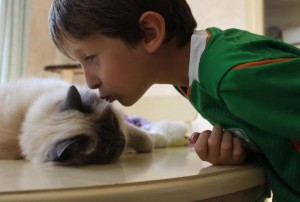What can a fluffy grey cat from Davyhulme teach us about helping children with Special Educational Needs? Two year-old Jessi-Cat (tweet her here) became an international news sensation earlier year when she was crowned National Cat of the Year. Cats Protection recognised Jessi-Cat’s exceptional relationship with her human companion, seven year-old Lorcan Dillon, who suffers from Selective Mutism.
Children with Selective Mutism find it difficult or impossible to speak or express themselves in a range of contexts (e.g. at school), but when Lorcan’s mother, Jayne Dillon, brought Jessi-Cat home, it was the beginning of a transformative relationship that attracted global interest.
Describing Jessi-Cat as, “without a doubt the best friend a boy could have,” Jayne says that Lorcan’s feline friendship has helped her son express himself through stroking his cat and playing with her, and that he has even been able to say, “I love you,” for the first time.
Jayne has prepared a guest blog post for us on Selective Mutism, but what are the wider lessons we can learn from Jessi-Cat?
Jessi-Cat’s Dos and Don’ts for helping special children
1. Don’t attempt to ‘cure’ a child by doing more of the same
Don’t try to draw conversation from a child with Selective Mutism by bombarding them with questions. Don’t try to make a dyslexic child better at reading and spelling by giving them more reading and spelling to do than every other child. School can be exhausting for children with SEN – just imagine being asked to do something you find almost impossibly difficult all day long – so I really do despair when I hear of children who struggle with handwriting or reading losing their break for ‘extra lessons’. Yes. This happens.
2. Give the child the tools they need to self-help
By bringing Jessi-Cat home, Lorcan’s mother was providing him with the tool he needed to help him communicate. This means that Lorcan can feel a sense of achievement in his relationship with Jessi-Cat, which will raise his self-esteem and may help ease his anxieties around social communication. So if using a calculator (in a limited way) helps a dyscalculic child explore patterns in maths or if using a reading overlay helps a dyslexic child access books, let the child use them.
3. Think outside the box of the classroom
Helping special children isn’t always about tick-boxes and Individual Education Plans (IEPs), useful though these can be. Sometimes a more creative approach or, more usually, a combination of approaches, is called for. Therapy cats are a creative, yet effective support for various conditions, including Selective Mutism. Jessi-Cat won’t attract praise from Ofsted but she has had a greater impact on Lorcan’s progress in school than any number of classroom interventions. So we need to investigate, for example, how juggling lessons can have a dramatic effect on dyslexic children, and if a child with Asperger Syndrome has an obsessive interest in, for example, buses or radiators or the colour blue, shouldn’t we be centring learning activities around that interest rather than attempting to use the National Curriculum as a distraction from their interest?
4. Be a friend
Be patient, be kind, be there, but don’t get in the face of a special child too much. Always take a step back so that the help you offer responds to their needs. Take the pressure off: Jessi-Cat helps Lorcan express himself because she doesn’t make demands or have unrealistic expectations.



Pingback: New Asperger's Support Group Meeting in Urmston this Week | Better Tuition